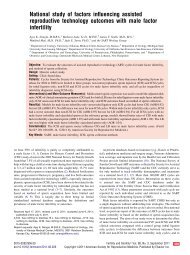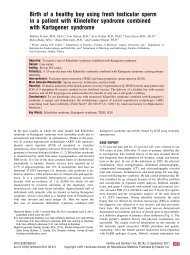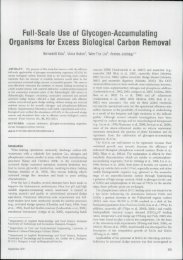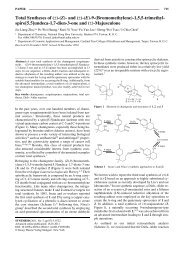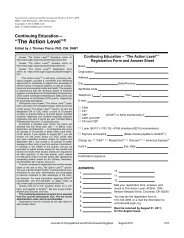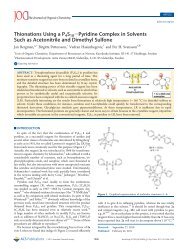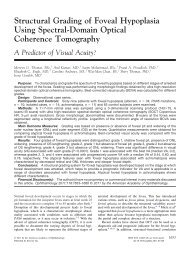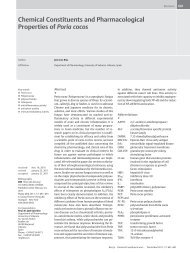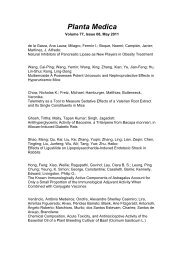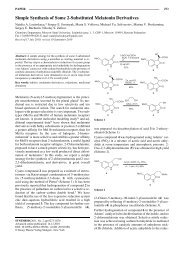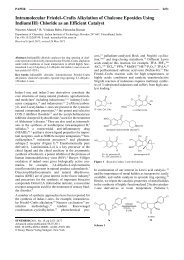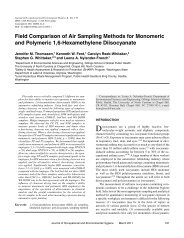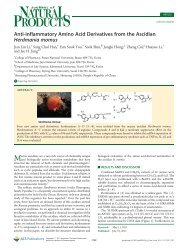Functional and anatomic results after creation of a neovagina ...
Functional and anatomic results after creation of a neovagina ...
Functional and anatomic results after creation of a neovagina ...
You also want an ePaper? Increase the reach of your titles
YUMPU automatically turns print PDFs into web optimized ePapers that Google loves.
MATERIALS AND METHODS<br />
Between June 2001 <strong>and</strong> September 2009, 17 consecutive young women with<br />
MRKH syndrome were surgically treated with neovaginoplasty according to<br />
the Wharton-Sheares-George technique at the Department <strong>of</strong> Obstetrics <strong>and</strong><br />
Gynecology, Medical University <strong>of</strong> Vienna, Austria. All operations were<br />
performed by the same gynecologist (R.W.).<br />
All women underwent an extensive preoperative diagnostic workup, including<br />
an intravenous pyelography to detect anomalies <strong>of</strong> the urinary tract.<br />
The surgical procedure is described in detail by Sch€atz et al. (36). After local<br />
pretreatment with estriol cream for 3 weeks, a diagnostic laparoscopy was<br />
performed under general anesthesia for orientation <strong>and</strong> confirmation <strong>of</strong> the<br />
abdominal organs. Afterward, the rudimentary M€ullerian ducts (which could<br />
be identified in all patients, 2 cm dorsal to the external urethral ostium <strong>and</strong> 1<br />
cm paramedially) were dilated incrementally by gently pushing Hegar dilatators<br />
(2.5–14) in the direction <strong>of</strong> the pelvic axis (Fig. 1). The median raphe<br />
was intersected with diathermy, <strong>and</strong> subsequently, a vaginal mold, coated<br />
with estriol, was inserted into the newly created cavity. On the seventh<br />
day, the vaginal mold was exchanged for a larger one. Based on our experience<br />
as well as recommendations in the literature (16, 19, 30), patients were<br />
advised to continue using the plastic mold for the first 3 postoperative<br />
months, day <strong>and</strong> night, to prevent stenosis <strong>and</strong> shrinking <strong>of</strong> the <strong>neovagina</strong>.<br />
After this period, normal sexual intercourse was possible.<br />
All patients with MRKH syndrome who had been treated surgically according<br />
to the Wharton-Sheares-George technique at the Department <strong>of</strong> Obstetrics<br />
<strong>and</strong> Gynecology, Medical University <strong>of</strong> Vienna, Austria (n ¼ 17),<br />
were invited for a follow-up evaluation, conducted from September 2009<br />
to February 2010. Three women were excluded from the study because <strong>of</strong><br />
a follow-up time <strong>of</strong> less than 3 months. Three patients were lost to followup<br />
because <strong>of</strong> changes in their addresses <strong>and</strong> cell phone numbers, <strong>and</strong> 1<br />
woman refused to return because <strong>of</strong> a new job a greater distance away. Therefore,<br />
10 patients could be included in this open study evaluating the longterm<br />
functional <strong>and</strong> <strong>anatomic</strong> success <strong>of</strong> the operation.<br />
Institutional Review Board approval was obtained for the study, <strong>and</strong><br />
women gave their verbal <strong>and</strong> written informed consent before inclusion.<br />
All procedures were performed in accordance with the st<strong>and</strong>ards <strong>of</strong> the responsible<br />
ethics committee.<br />
At the follow-up visit, participants underwent a gynecologic examination,<br />
including palpation, pelvic ultrasound, vaginal swab, bacterial culture, Papanicolaou<br />
(PAP) smear, hybrid capture test for human papillomavirus (HPV)<br />
typing, <strong>and</strong> biopsy. Afterward, women were asked to grade the severity <strong>of</strong><br />
pain during the examination on a 100-mm visual analogue scale (VAS). Individual<br />
quality <strong>of</strong> psychosexual life <strong>and</strong> overall subjective degree <strong>of</strong> satisfaction<br />
with the operation were assessed by 2 specific questionnaires.<br />
The Rosen Female Sexual Function Index (FSFI) questionnaire, validated<br />
for the German-speaking population, contains 19 st<strong>and</strong>ardized questions for<br />
the evaluation <strong>of</strong> female sexual quality <strong>of</strong> function (i.e., desire, arousal, orgasmic<br />
<strong>and</strong> sexual pain disorder, quality <strong>of</strong> vaginal lubrication, <strong>and</strong> global<br />
sexual <strong>and</strong> relationship satisfaction) (37). Women were also asked to fill<br />
out a second questionnaire created by our group containing 23 specific questions<br />
to elucidate the individual medical history <strong>and</strong> current situation <strong>of</strong> the<br />
patients (e.g., influence <strong>of</strong> the diagnosis <strong>and</strong> surgical treatment on selfesteem,<br />
sexual life, <strong>and</strong> relationships). Well-being scores before surgery<br />
compared with the present time were recorded at the follow-up examination.<br />
The main outcome measure <strong>of</strong> the present study was the functional (satisfaction<br />
with sexual parameters <strong>and</strong> quality <strong>of</strong> life), long-term result <strong>of</strong> the<br />
surgical procedure. In addition, we evaluated the <strong>anatomic</strong> (length <strong>and</strong> width<br />
<strong>of</strong> the <strong>neovagina</strong>, structure <strong>of</strong> the vaginal epithelium, <strong>and</strong> type <strong>of</strong> bacterial<br />
colonization) outcome.<br />
RESULTS<br />
At the time <strong>of</strong> the neovaginoplasty according to Wharton-Sheares-<br />
George, the mean age <strong>of</strong> the patients was 20.0 5.8 years (range,<br />
15–34 years). Mean follow-up since the operation was 33.5<br />
22.4 months (range, 3–77 months).<br />
All operations had been performed without major complications.<br />
In 6 patients, minor old blood secretions were found during the<br />
Fertility <strong>and</strong> Sterility â<br />
FIGURE 1<br />
Vaginal dimple—rudimentary M€ullerian ducts. Hegar is pointing to<br />
the left M€ullerian duct.<br />
Walch. Long-term outcomes <strong>after</strong> Wharton-Sheares-George surgery. Fertil Steril 2011.<br />
exchange <strong>of</strong> the vaginal mold on the seventh postoperative day. In<br />
1 patient, elevated body temperature occurred postoperatively concomitant<br />
with fluid retention in the <strong>neovagina</strong>l region but was<br />
treated effectively with antibiotics; no surgical intervention was<br />
needed. Eight patients reported mild abdominal pain during the first<br />
postoperative days; analgesic medication was administered. Mean<br />
operation time, including diagnostic laparoscopy (additional adhesiolysis<br />
in 1 patient <strong>and</strong> tubectomy in another), was 46 9 minutes<br />
(range, 30–65 minutes). The mean time for Wharton-Sheares-<br />
George dilation was 21.5 2 minutes (range, 20–25 minutes).<br />
Four <strong>of</strong> the 10 patients (40%) presented with congenital inguinal<br />
hernia in their medical history. In all <strong>of</strong> these patients, surgical treatment<br />
had been performed successfully in the past. In one <strong>of</strong> the patients,<br />
multiple skeletal anomalies (Morbus Sprengel) <strong>and</strong> a throat<br />
fistula had also been found. Another patient demonstrated a pelvic<br />
kidney on the left side.<br />
At the follow-up investigation, the external genitals were regular<br />
in all patients, <strong>and</strong> no prolapse <strong>of</strong> the <strong>neovagina</strong> had occurred postoperatively<br />
in any <strong>of</strong> the patients. A gynecologic examination with 2<br />
st<strong>and</strong>ard specula (Breisky anterior speculum, 100 25; Matzenauer<br />
posterior speculum, 100 25 mm; KLS Martin Group) could be<br />
performed in every patient. The mean score for severity <strong>of</strong> pain during<br />
the examination was 12 11 (range, 0–30; no pain at all, 0 <strong>and</strong><br />
maximum, 100).<br />
In 9 <strong>of</strong> 10 patients, the <strong>neovagina</strong> appeared macroscopically<br />
regular; in 1 patient, the process <strong>of</strong> epithelialization was not yet<br />
complete because the time since the operation was relatively short<br />
(



